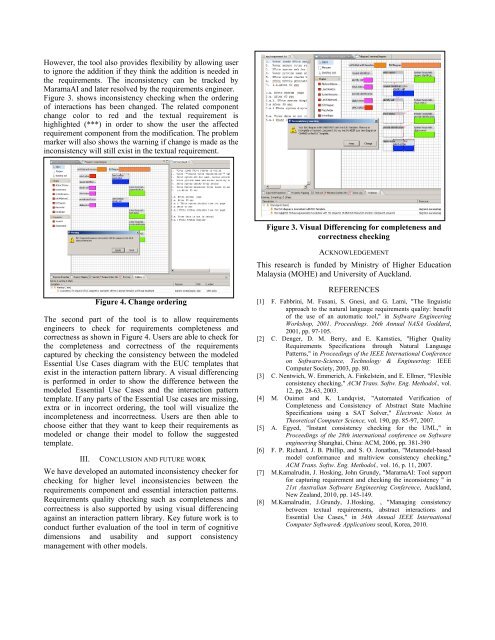Marama AI: Automated and Visual Approach for ... - ResearchGate
Marama AI: Automated and Visual Approach for ... - ResearchGate
Marama AI: Automated and Visual Approach for ... - ResearchGate
You also want an ePaper? Increase the reach of your titles
YUMPU automatically turns print PDFs into web optimized ePapers that Google loves.
However, the tool also provides flexibility by allowing user<br />
to ignore the addition if they think the addition is needed in<br />
the requirements. The inconsistency can be tracked by<br />
<strong>Marama</strong><strong>AI</strong> <strong>and</strong> later resolved by the requirements engineer.<br />
Figure 3. shows inconsistency checking when the ordering<br />
of interactions has been changed. The related component<br />
change color to red <strong>and</strong> the textual requirement is<br />
highlighted (***) in order to show the user the affected<br />
requirement component from the modification. The problem<br />
marker will also shows the warning if change is made as the<br />
inconsistency will still exist in the textual requirement.<br />
Figure 3. <strong>Visual</strong> Differencing <strong>for</strong> completeness <strong>and</strong><br />
correctness checking<br />
ACKNOWLEDGEMENT<br />
This research is funded by Ministry of Higher Education<br />
Malaysia (MOHE) <strong>and</strong> University of Auckl<strong>and</strong>.<br />
Figure 4. Change ordering<br />
The second part of the tool is to allow requirements<br />
engineers to check <strong>for</strong> requirements completeness <strong>and</strong><br />
correctness as shown in Figure 4. Users are able to check <strong>for</strong><br />
the completeness <strong>and</strong> correctness of the requirements<br />
captured by checking the consistency between the modeled<br />
Essential Use Cases diagram with the EUC templates that<br />
exist in the interaction pattern library. A visual differencing<br />
is per<strong>for</strong>med in order to show the difference between the<br />
modeled Essential Use Cases <strong>and</strong> the interaction pattern<br />
template. If any parts of the Essential Use cases are missing,<br />
extra or in incorrect ordering, the tool will visualize the<br />
incompleteness <strong>and</strong> incorrectness. Users are then able to<br />
choose either that they want to keep their requirements as<br />
modeled or change their model to follow the suggested<br />
template.<br />
III.<br />
CONCLUSION AND FUTURE WORK<br />
We have developed an automated inconsistency checker <strong>for</strong><br />
checking <strong>for</strong> higher level inconsistencies between the<br />
requirements component <strong>and</strong> essential interaction patterns.<br />
Requirements quality checking such as completeness <strong>and</strong><br />
correctness is also supported by using visual differencing<br />
against an interaction pattern library. Key future work is to<br />
conduct further evaluation of the tool in term of cognitive<br />
dimensions <strong>and</strong> usability <strong>and</strong> support consistency<br />
management with other models.<br />
REFERENCES<br />
[1] F. Fabbrini, M. Fusani, S. Gnesi, <strong>and</strong> G. Lami, "The linguistic<br />
approach to the natural language requirements quality: benefit<br />
of the use of an automatic tool," in Software Engineering<br />
Workshop, 2001. Proceedings. 26th Annual NASA Goddard,<br />
2001, pp. 97-105.<br />
[2] C. Denger, D. M. Berry, <strong>and</strong> E. Kamsties, "Higher Quality<br />
Requirements Specifications through Natural Language<br />
Patterns," in Proceedings of the IEEE International Conference<br />
on Software-Science, Technology & Engineering: IEEE<br />
Computer Society, 2003, pp. 80.<br />
[3] C. Nentwich, W. Emmerich, A. Finkelstein, <strong>and</strong> E. Ellmer, "Flexible<br />
consistency checking," ACM Trans. Softw. Eng. Methodol., vol.<br />
12, pp. 28-63, 2003.<br />
[4] M. Ouimet <strong>and</strong> K. Lundqvist, "<strong>Automated</strong> Verification of<br />
Completeness <strong>and</strong> Consistency of Abstract State Machine<br />
Specifications using a SAT Solver," Electronic Notes in<br />
Theoretical Computer Science, vol. 190, pp. 85-97, 2007.<br />
[5] A. Egyed, "Instant consistency checking <strong>for</strong> the UML," in<br />
Proceedings of the 28th international conference on Software<br />
engineering Shanghai, China: ACM, 2006, pp. 381-390<br />
[6] F. P. Richard, J. B. Phillip, <strong>and</strong> S. O. Jonathan, "Metamodel-based<br />
model con<strong>for</strong>mance <strong>and</strong> multiview consistency checking,"<br />
ACM Trans. Softw. Eng. Methodol., vol. 16, p. 11, 2007.<br />
[7] M.Kamalrudin, J. Hosking, John Grundy, "<strong>Marama</strong><strong>AI</strong>: Tool support<br />
<strong>for</strong> capturing requirement <strong>and</strong> checking the inconsistency " in<br />
21st Australian Software Engineering Conference, Auckl<strong>and</strong>,<br />
New Zeal<strong>and</strong>, 2010, pp. 145-149.<br />
[8] M.Kamalrudin, J.Grundy, J.Hosking, , "Managing consistency<br />
between textual requirements, abstract interactions <strong>and</strong><br />
Essential Use Cases," in 34th Annual IEEE International<br />
Computer Software& Applications seoul, Korea, 2010.
















